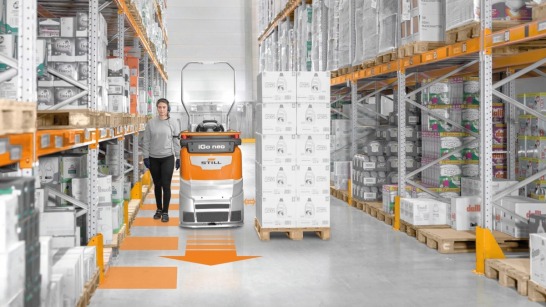It is well known in the industry that the demands and expectations placed on the stability of all KION Group industrial truck components have always been very high. The KION brands Dematic, Linde Material Handling and STILL carry out rigorous, complex, and extensive testing procedures before each new product launch to ensure that the trucks are fit for practical use. In this process, conventional, physical test procedures are increasingly being supplemented by virtual tests.
Practical Relevance and Error Analysis through Data Transparency
In the case of AGVs, system integration is then followed by the next step at the Belgian test center, which is known as prevalidation: This step focuses on the relevant industry-specific safety requirements. It involves a major step towards bringing the device being tested closer to real-world applications: For example, pick and drop routes are now programmed in and run several times in succession in the test center. This is done while taking into account the relevant safety regulations at all times, because needless to say, all guidelines, specifications, and laws must be complied with in automated operation. In order to create conditions that are as close as possible to subsequent customer use, different warehouse layouts are set up, and various obstacles are positioned and retested each time: Does the AGV register them in time? Do the sensors detect all angles, does the stop mechanism work, does the truck avoid obstacles correctly?
Finally, the prevalidation phase transitions smoothly into the validation phase: The driverless transport system has to prove that it can navigate efficiently in a space and make optimal use of its speed. In practice, this involves the following: The layout contains several filled pallets that are to be picked up independently by the AGVs and brought to the target position according to a specific protocol. This is repeated numerous times, with continually changing spatial variables, until all possible application environments have been checked. When performing an error analysis, KION Mobile Automation’s test center relies on maximum data transparency—and on the Group’s own diagnostic tools, such as Linde Material Handling’s AGV Insights. This software collects process data and enables cloud monitoring, as the data from an AGV tells a story. Crucial KPIs such as response time, availability, and reliability can be viewed at any time via the tool, and the AGV’s entire movement history is completely transparent. This also means that the routes within the particular warehouse layout can be checked, retraced, and, of course, optimized at any time. All data is stored in the cloud and processed using trend analyses, so that the test engineers do not miss even the smallest of details.
During the course of this multi-stage and complex validation process, all types of errors or bugs can be identified and corrected until no further adjustments are necessary and the security requirements are met. This concludes the work of the test engineers at KION Mobile Automation for now. For now? For now. This is because after a new product has been produced in the factory, there is another test loop before an AGV is shipped out to the customer. “At KION, we prefer to play it safe,” explains test engineer Lemoine. There are only a few companies in the world that are able to develop, produce, and test an AGV completely in-house from the concept phase to the implementation phase. “I’m proud that the KION Group is one of the few companies that can do this,” remarks Lemoine.




